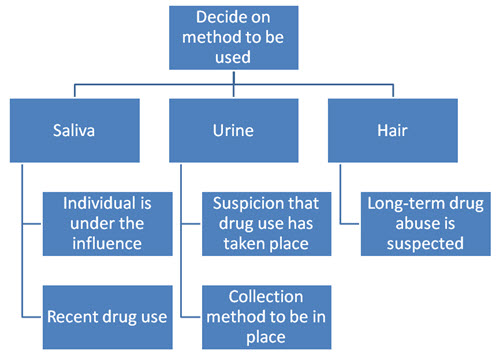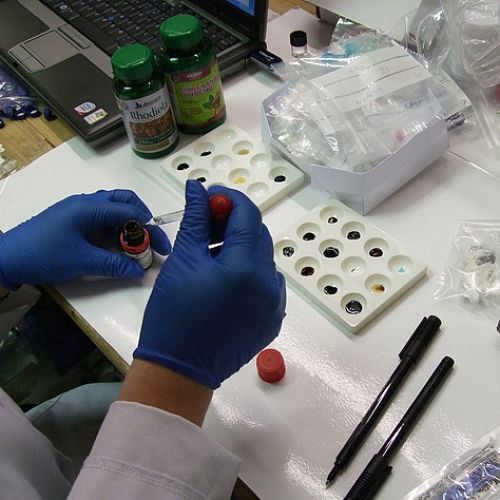In nearly any company with employees, there is a very good chance that some of them use drugs on at least an occasional basis. Depending on the nature of your business, an employee who is using drugs can place your business at risk in a number of ways. Without a drug policy, you have no way of managing the risk. By implementing a drug testing policy, you can find out and deal with the problem accordingly. As an employer you are legally allowed to test your staff for drug use.
You can test for drugs at work in three ways; saliva, urine, or hair. Each type of test works differently and tests for drug use over a different time frame, so they are not interchangeable. For this reason, we are experts in all of these and we can provide authoritative information on all options and help you decide which one fits your needs the best. No matter what type of test you need or what drugs you want to test for, we have the most thorough and reliable tests available.
The Impact of Drug Testing on Workplace Culture
Drug testing isn’t just about catching users—it’s about fostering a culture of safety and responsibility. When you implement a drug testing programme, you’re sending a clear message: “We care about your wellbeing and the safety of everyone here.”
But let’s face it, drug testing can be a touchy subject. Some employees might feel it’s an invasion of privacy. That’s why communication is key. Be transparent about your policies and the reasons behind them. Explain how drug use can impact job performance and safety.
Consider offering support programmes alongside testing. If an employee tests positive, having resources ready—like counselling or rehabilitation options—shows you’re not just looking to punish, but to help.
Remember, the goal isn’t to create a culture of fear, but one of trust and mutual respect. When done right, drug testing can actually boost morale by ensuring everyone’s working in a safe, drug-free environment.
Why Are There Three Kinds? Which One Should I Use?
They’re all best for a different time frame of use. The best one will depend on whether you want to test whether someone is currently under the influence, they’ve used recently (but not currently under the influence), or whether they’ve used in the past, though they may be clean right now. The table shows the main differences between these types of tests.

So for example, if you snort cocaine, it will reach your brain in a matter of seconds. In a few minutes, it will be detectable in your saliva, but the only way it will be detectable in your urine is if you have used it at least one other time in the past few days to weeks. Within hours, it will be detectable in your urine, though it may no longer be detectable in saliva. A couple of weeks later, it can be found in your hair, though unless you’re a habitual user, it will no longer be detectable in your urine or saliva.
In short, each test will detect drugs used within a specific time prior to the test, but not drugs used outside of that window. Many times casual drug users will abstain from drug use when they know they may be subjected to a drug test. In these cases, the only way to find out is through hair. This is especially helpful if the person is being considered for a key position. You may not care about an individual’s history, and you’re reasonably certain they’re not under the influence at the moment, but you do want to check for drug use in the relatively recent past, you’ll want to run a urine test. Conversely, you might not care what someone does in their off time, but you want to find out if someone is coming to work impaired, in which case you would want a saliva test.
To summarise:
- Saliva tests detect current impairment
- Urine tests detect drugs used in the previous few days to weeks, depending on the drug, and
- Hair tests detect drugs used in previous months, but not within the past several days.
It is also possible to detect drugs in blood, sweat, and tears, but these are more commonly used in forensics. Blood is not as easy to collect as the previous methods and requires complex lab tests. It is difficult to ensure sweat is not contaminated. As for tears, do you really want to make your employees cry to ensure they’re not using drugs? Neither do we.
Only a saliva test can tell you if someone is actually under the influence, and that’s what is really important in most workplace situations. For new employee screening, hair analysis is best. But urine testing is one of the most commonly used, ‘instant’ tests.
Which Type of Drug Test Is Best for Me?
When it comes to choosing which type of drug test to use, it ultimately depends on the situation and what you want to achieve. If you want to screen for drug use in a new employee or potential candidate, hair analysis is the most effective option. If you suspect someone is currently impaired and want to ensure workplace safety, a saliva test is the way to go. And if you want to detect recent drug use, a urine test is the most commonly used and efficient option.
It’s important to note that drug tests are not foolproof and can sometimes produce false results. It’s crucial to follow proper testing procedures and confirm positive results with a lab analysis before making any employment decisions.
In conclusion, drug testing is a vital aspect of maintaining a safe and productive workplace. Understanding the different types of drug tests and their purposes can help you make informed decisions when implementing a drug testing programme in your company.
Photo: Image courtesy of ukhomeoffice on Flickr
Zoom Testing is a leading UK drug testing company and a supplier of Drug Test Kits.
This post was originally published in November 2014 and has been updated regularly since, with the most recent update in 2024.





